The Belgian Pro League is finally back this weekend, with the first match of the new campaign occurring on Friday night. It also happens to be a Brussels derby for the first match of the new season, with Alexander Blessin’s Union Saint-Gilloise welcoming Brian Riemer’s Anderlecht to the Stade Joseph Marien.
However, we will look at this matchup from a different angle instead of just a basic match preview. When analysing the transfer activity of both sides, they are two of the most profitable clubs in Belgian football this transfer window, and the question is whether they could effectively replace their departed stars.
USG lost a few key starters for the Brussels-based side last campaign, with Nigerian striker Victor Boniface being sold to Bayer Leverkusen for a fee of over €20m. In contrast, club captain Teddy Teuma was sold to Reims in France. They also lost two centre-backs, with Siebe van der Heyden being sold to Mallorca and Ismaël Kandouss to Gent. Regarding key incomings, USG made Koki Machida’s loan move from Kashima Antlers permanent while also bringing in Liverpool midfielder Alexis Mac Allister’s brother Kevin from Argentinos Juniors as another centre-back option.
Blessin’s side also strengthened the midfield area, with Charles Vanhoutte coming in from Cercle Brugge and 25-year-old Norwegian Mathias Rasmussen coming in from Eliteserian side Brann. For centre-forward depth, they brought in 25-year-old Elton Kabangu from Willem II on a free transfer as well, adding depth to the group after the departure of Boniface.
Brian Riemer’s Anderlecht were not as active in the transfer market as their Brussels counterparts, but they still had to deal with losing some players. None is probably more impactful than Dutch U21 goalkeeper Bart Verbruggen, who was sold to Brighton for a substantial fee. The club also sold some depth players, with midfielder Kristoffer Olsen being sold to Midtjylland, backup goalkeeper Hendrik van Crombrugge being sold to Genk, and losing Lior Refaelov on a free transfer to Maccabi Haifa.
Regarding incomings for Anderlecht, their biggest is the signing of former Ajax and Nice striker Kasper Dolberg and bringing in Belgian U21 fullback Louis Patris from Leuven. The club also brought in their new starting goalkeeper to replace Bart Verbruggen, with 30-year-old Frenchman Maxime Dupé coming in from Toulouse on a free transfer.
This data analysis piece will go over both clubs’ key transfers this summer, looking at how they fit into their new manager’s tactics, how they compare to the Player they are replacing, and also potentially seeing who did the better business.
Union Saint-Gilloise – Victor Boniface vs. Elton Kabangu
Now we will look more in-depth into the new signings of each side, looking at how they may fit into the manager’s tactics and their general fit into the squad. Starting with USG, the Belgian side’s most significant departure was undoubtedly Nigerian striker Victor Boniface, who was sold to Xabi Alonso’s Bayer Leverkusen for a substantial fee.
The introduction of Elton Kabangu on a free transfer leaves Blessin with three recognised centre-forwards at his disposal, with the German manager preferring a 3-5-2 formation. Along with Kabangu, the Belgian side have 26-year old German Dennis Eckert, who they brought in on a free last summer from FC Ingolstadt, and 26-year-old Swede Gustaf Nilsson, who was also brought in last summer from German side Wehen Wiesbaden.
Looking back at last season, Boniface played in 55 matches in all competitions for USG, scoring 22 goals and contributing 12 assists. This is a huge number of goal contributions that the Belgian side is losing, with the three aforementioned players having the majority of responsibility on their shoulders. Meanwhile, Nilsson managed 11 goals in all competitions last season, while Eckert only scored 3.
It would however be unsurprising to see Elton Kabangu come in and start right away for Alexander Blessin’s side, with the 25-year-old forward scoring 13 goals and grabbing another six assists for Willem II last season in the Eerste Divisie. Getting the forward on a free transfer could also be a pretty good piece of business for the Belgian side, with them not having the biggest budget of the Belgian sides.
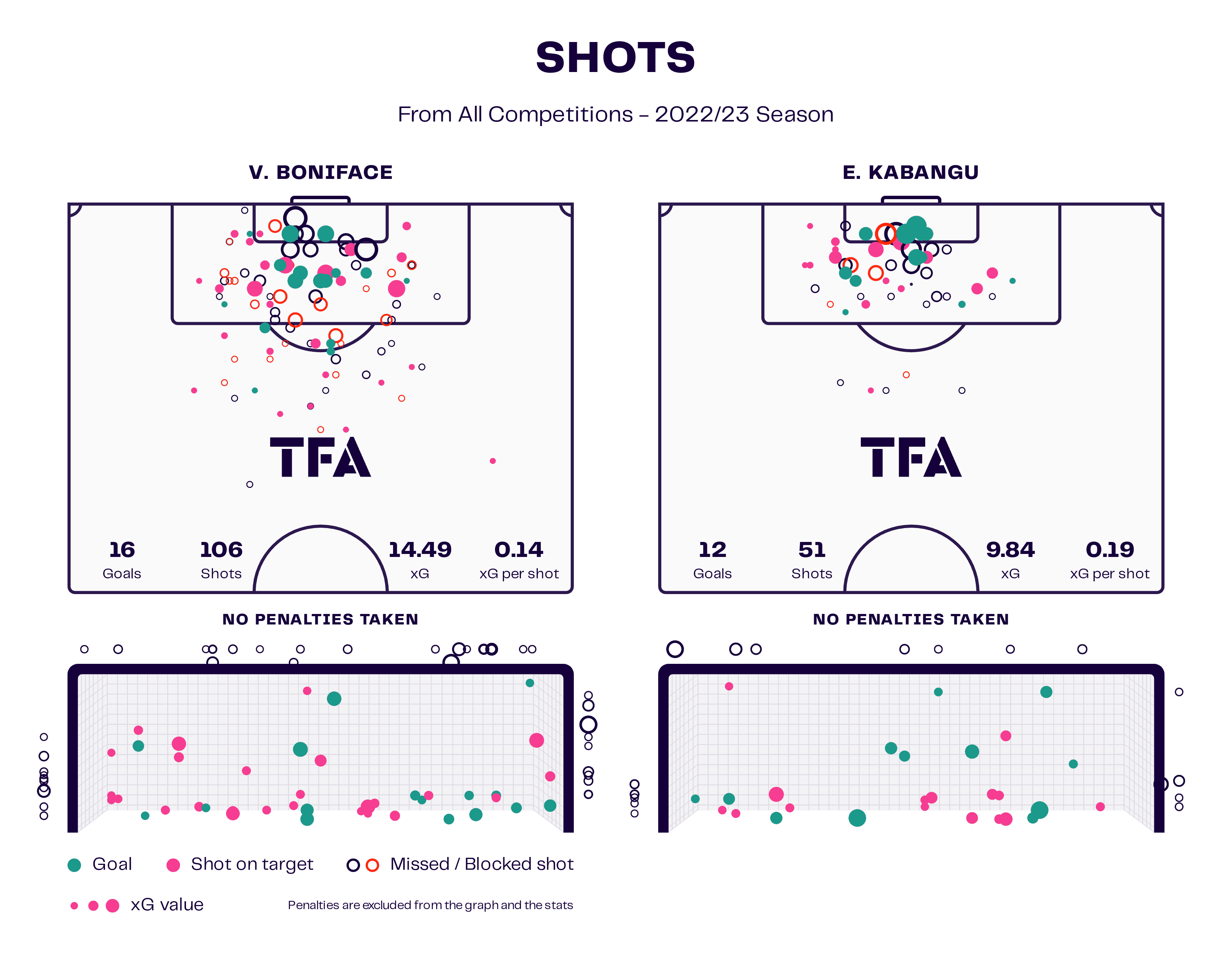
The data viz graphic above shows the shots taken and goals scored by both Victor Boniface and Elton Kabangu in all competitions last season. While Boniface scored more goals, Kabangu took fewer shots, resulting in a higher xG per shot. However, USG were one of the strongest teams in Belgium last season, with them usually outshooting their opponents throughout a match. At the same time, Willem II were not as dominant in the Dutch second division.
Also, Kabangu’s shots are more concentrated around the penalty spot and six-yard box, with all but five of his shots coming from outside the 18-yard box. Both strikers overperformed their xG for last season, meaning there could be a slight drop-off for both next season. Looking at it from face value, it seems like Kabangu could be a viable replacement for the departed Boniface. However, it is best to look deeper to see how he compares directly to the Nigerian forward.
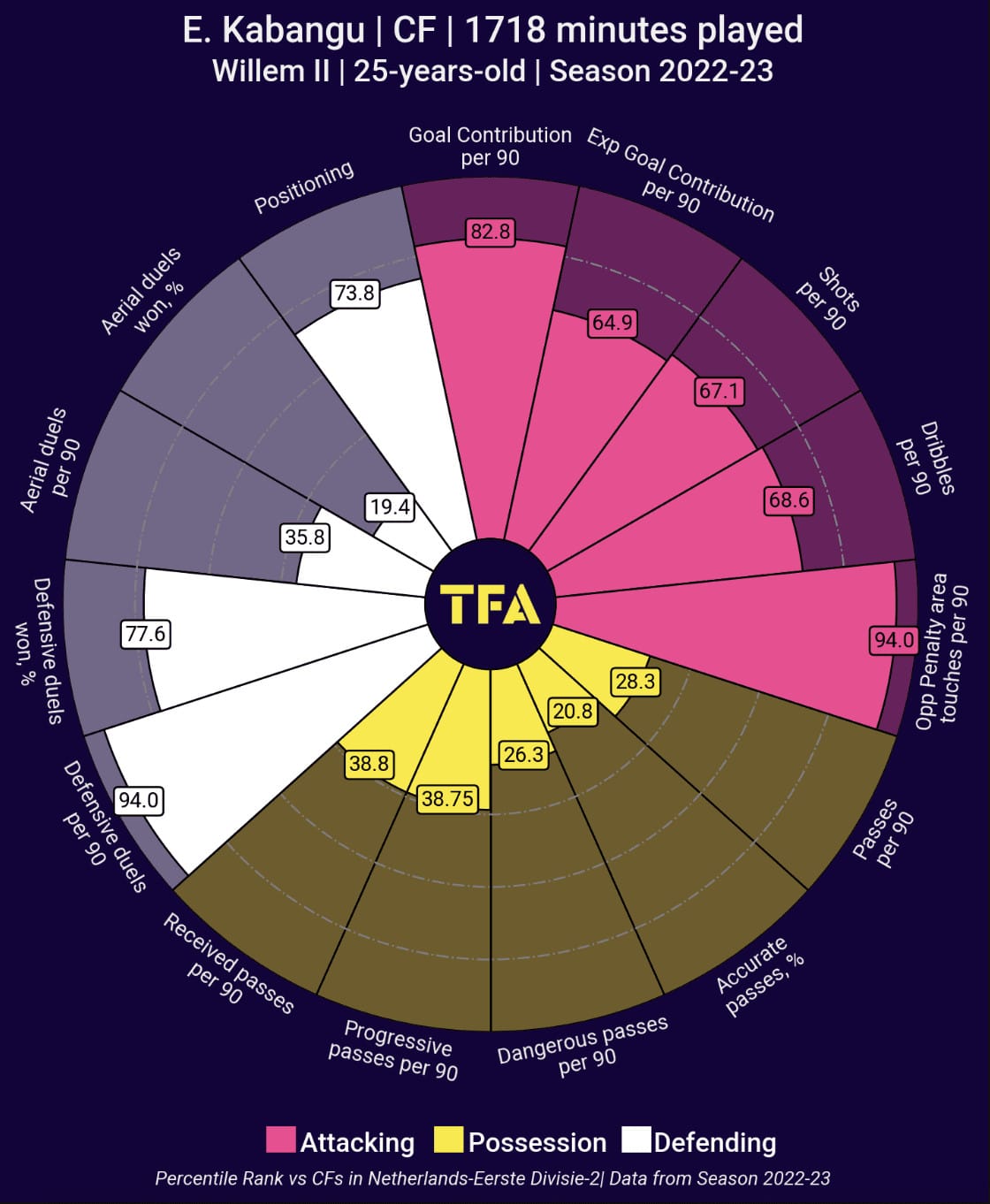
The pizza chart above shows the percentile rankings of Elton Kabangu compared to the other CFs in the Eerste Divisie last season. As we can see, the 25-year-old is not much of a possession forward; instead, he looks to play off the shoulders of the last defenders and operate in spaces in and around the penalty box.
This is highlighted by his 94th percentile ranking of opposition penalty area touches per 90 minutes and an 83rd percentile ranking in goal contributions per 90 minutes. Kabangu also will get involved in the defensive side of the game, with the striker holding a 94th percentile rank in defensive duels per 90 minutes and a 78th percentile ranking in defensive duels won percentage.
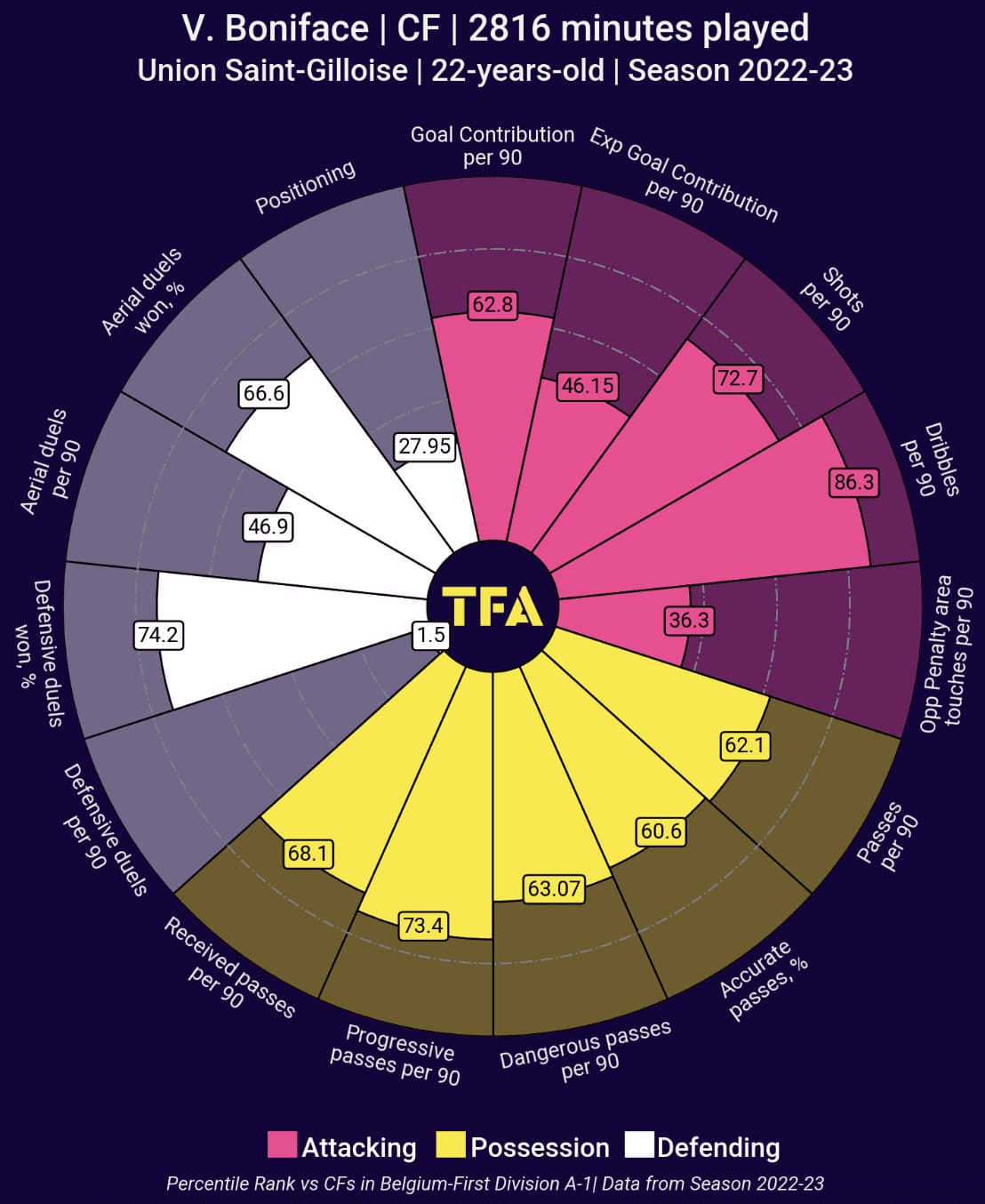
The pizza chart above shows Victor Boniface’s involvement in all sides of the game from last season. The first thing that stands out is that Boniface is more involved in the possession side of the game than Kabangu is, with him ranking much higher in all passing metrics. This also highlights the Nigerian’s ability to drop into midfield and receive the ball in deeper positions, with the 22-year-old also looking to turn provider sometimes.
Kabangu has a big task on his hands, replacing the goalscoring and assist ability of Victor Boniface, and with a different style of play compared to the Nigerian striker, he is not a like-for-like replacement up top for Alexander Blessin and Union Saint-Gilloise. Regarding his potential fit in how Blessin likes to play, the German coach implements a Red Bull style of play, with him looking for his side to be a high-pressing side and one that can counter quickly. When looking at it from a tactical fit, Kabangu seems close to a perfect match, maybe even a better fit than Boniface would have been in the German’s tactics.
USG – Mathias Rasmussen vs. Teddy Teuma
Moving back into the midfield area for Union Saint-Gilloise, the loss of club captain Teddy Teuma to Stade de Reims is a massive blow for the midfield group that Alexander Blessin is inheriting. In 52 appearances in all competitions for the Belgian side last term, the 29-year-old Malta international scored 14 goals and registered 17 assists, with him being the heartbeat of this USG team. Teuma is an all-around midfielder, with the Malta international able to contribute on both the attacking and defensive side of the ball, something that Blessin would have probably loved to utilise.
Looking at Mathias Rasmussen, while he may not be an exact replacement for Teddy Teuma, the Norwegian has the talent to excel in Belgium. In 14 appearances with Brann last season, the Norwegian had four assists. However, his 2021/22 season was a massive one. In that campaign for Danish side Nordsjælland, the Norwegian midfielder had 17 goals and nine assists in 34 appearances in all competitions, showing the type of impact he can potentially have.

The heat maps above show the areas both Teddy Teuma and Mathias Rasmussen covered for their respective clubs last season in all competitions. As we can see from the graphics, they usually operated on opposite sides of the pitch last season, but both tended to drift anywhere in the midfield at times throughout matches. Let’s look at the pizza charts of the two midfielders to see how they compare in different aspects.
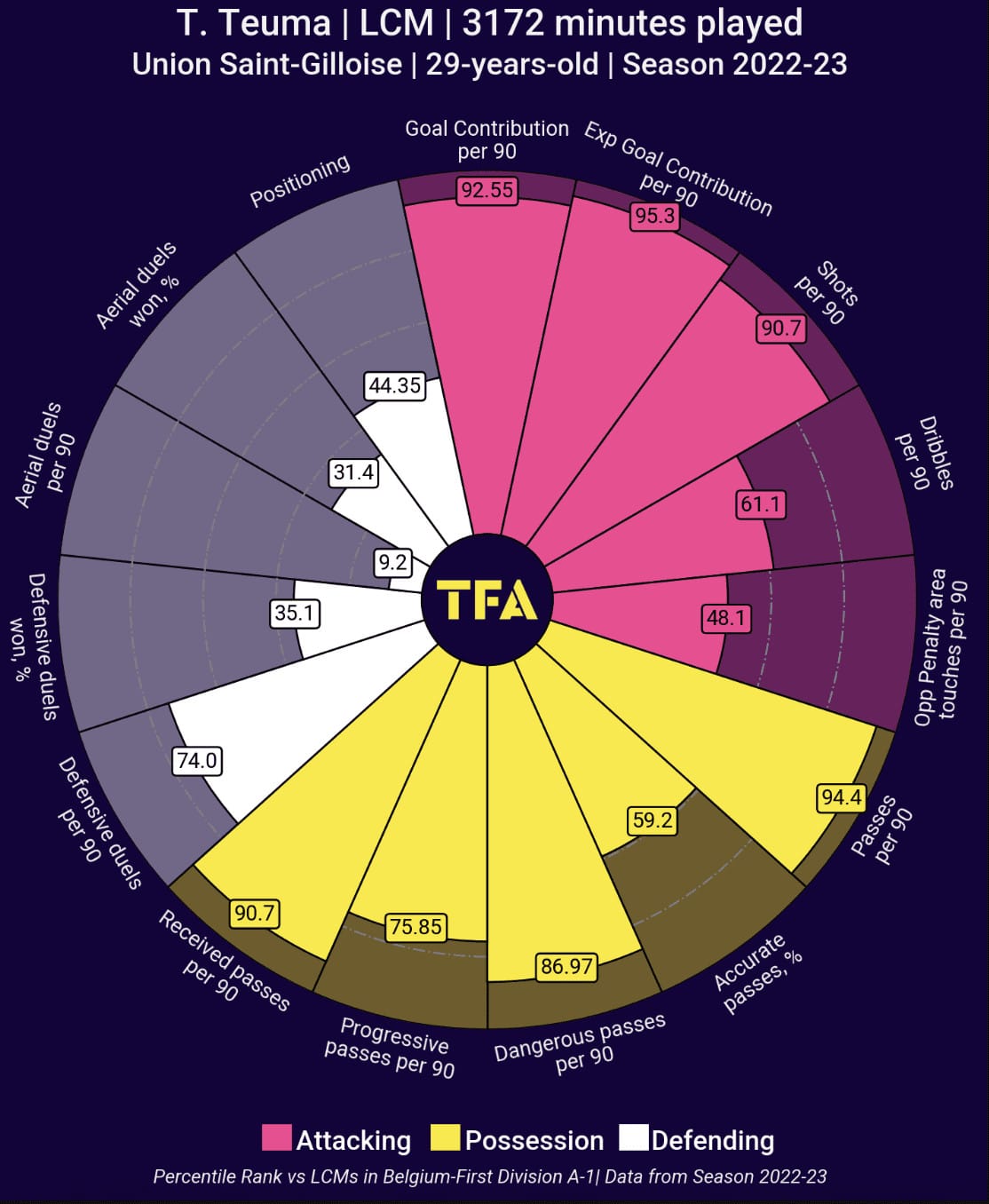
The pizza chart above shows the metrics of Teddy Teuma last season compared to other central midfielders in the Belgian Pro League. As we can see, Teuma is most dangerous in possession, with him ranking highly in passes and receiving passes per 90 minutes and dangerous passes per 90 minutes.
This highlights the distribution role that Teuma played for USG, with him being the bridge between the defenders and attackers. He also ranked highly in goal contributions, which was discussed earlier in this section. The Maltese is not as involved in the defensive side of the game, however, with him ranking relatively low in these metrics except for defensive duels per 90 minutes.
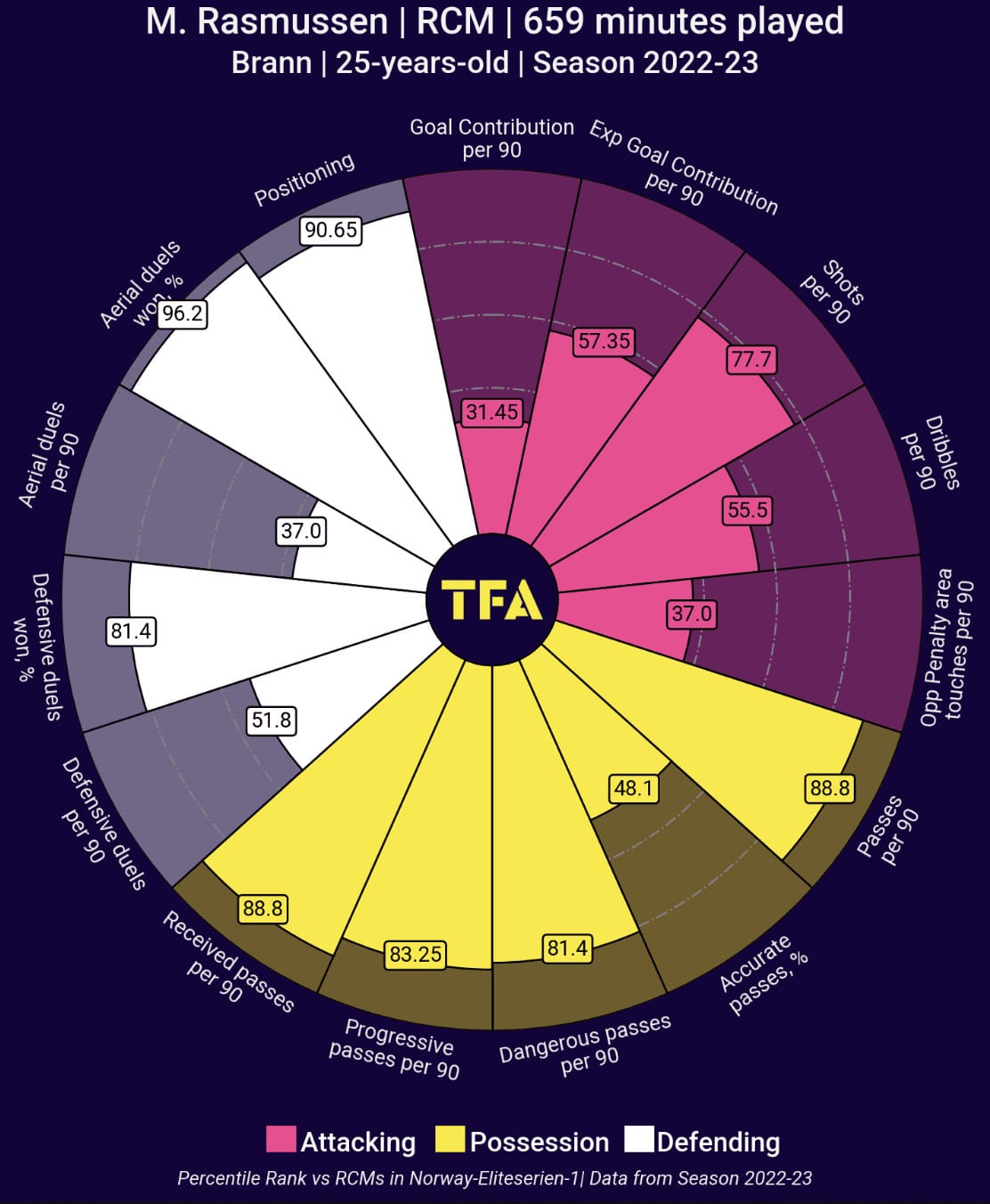
Now let us take a look at Mathias Rasmussen’s pizza chart from his short season with Brann in the Eliteserien. Though he played under 700 minutes, we are still able to get a good gauge of what the midfielder excels at compared to the man he is replacing. Like Teuma, Rasmussen mainly excels in the possession side of the game, with him also ranking highly in key passing metrics.
However, he did not rank highly in goal contributions for Brann, but this could also go down to the fact he had limited appearances for the club. With Nordsjælland, the 25-year-old Norwegian was more heavily involved in the game’s attacking side, so expect the same with USG. The Norwegian is also more prevalent in the defensive side of the game than Teuma, but this likely will not be the role Blessin deploys Rasmussen.
Under the German manager, expect Rasmussen to play a similar role to what Teuma did the last few seasons. This means the Norwegian will likely play as the #8 in Blessin’s midfield five, giving him the freedom to go forward and join the attack while also dropping and playing in more of a defensive role at times throughout the course of a match.
Anderlecht – Maxime Dupé vs. Bart Verbruggen
For Brian Riemer this season, the goalkeeping position is the one with the biggest question mark going into the new campaign. Last season, the Danish manager entrusted Dutch U21 international Bart Verbruggen, who, after a fantastic campaign, was sold to Brighton for a hefty fee. Anderlecht dipped into the free transfer market to replace him, bringing in 30-year-old Frenchman Maxime Dupé as their new #1 after his contract expired with Toulouse. The Frenchman made 113 appearances for Toulouse, winning the Ligue 2 title and the Coupe de France last season, making this signing a coup for Anderlecht.

The data viz graphic above shows the shots faced by both Bart Verbruggen (left) and Maxime Dupé (right). As we can see, Dupé faced substantially more xG last season, mainly due to the fact he played in front of a defence that was one of the weakest in Ligue 1. He did, however, prevent more goals last season than Verbruggen did, showing the quality he possesses in goal as a shot-stopper.
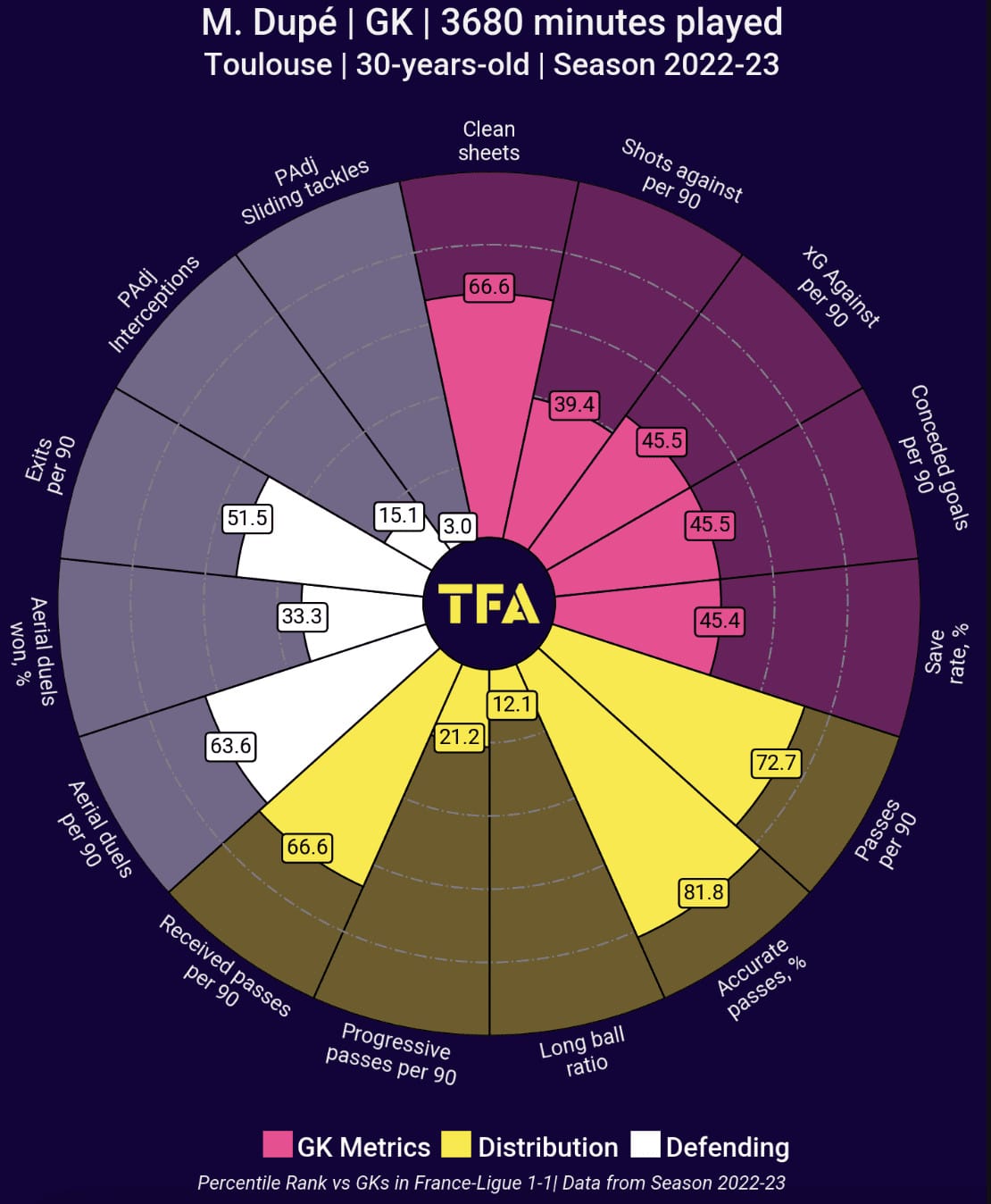
Above is the pizza chart of Maxime Dupé from last season, giving an idea of what style of play he typically uses. As we can see, compared to other goalkeepers in Ligue 1 last season, he ranks highly in accurate pass percentage and passes per 90 minutes, as well as received passes, showing his involvement in the game and with the ball at his feet. This indicates that Dupé is heavily involved in distribution, something that Brian Riemer wants his goalkeepers to be able to do and something that Verbruggen excelled at last season for the Belgian side.
Anderlecht – What impact can Kasper Dolberg have?
In another exciting signing this summer for Anderlecht, the Belgian side signed Kasper Dolberg from Nice, hoping to help revive the Danish striker’s career after having some tough recent seasons. After two loan spells last season, with Sevilla and then Hoffenheim, the 25-year-old was brought in from Nice this summer. He replaces Islam Slimani, with the 35-year-old Algerian having a fantastic six months in Brussels after signing for the club last January on a deal until the end of the season.

The data viz graphic above shows the heat map of Kasper Dolberg from the 2021/22 Ligue 1 season, his last campaign where he had the most impact for Nice. As the graphic shows, Dolberg mainly likes to stay around the penalty area, but he will sometimes drop into midfield to get on the ball in deeper positions.
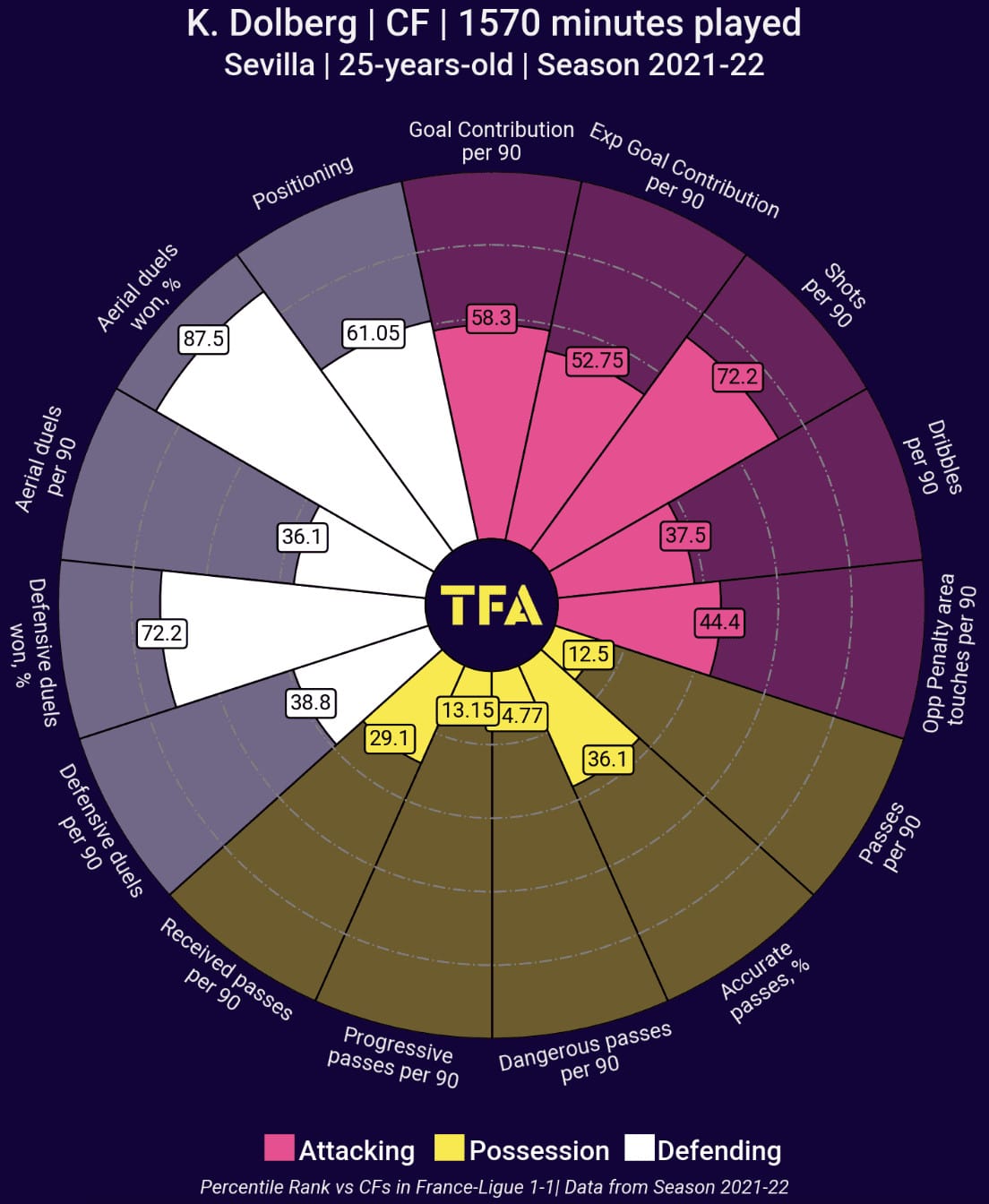
The pizza chart above also looks at Kasper Dolberg’s 2021/22 season with Nice, highlighting the different metrics. Interestingly, the Dane’s defensive metrics are relatively high compared to other forwards in Ligue 1, showing his tendency to press and put pressure on defenders that are in possession. This is something that Brian Riemer will appreciate, as the Dane has implemented a style of play at Anderlecht that utilises high pressing, something that was commonplace during his time as Thomas Frank’s assistant at Brentford.
And while his attacking metrics are not where you would expect them to be at, this was a season where he only managed seven goals for Nice in all competitions. In Belgium, it would be expected he would have a sizeable attacking contribution this coming season, based on the fact he likely will be the first choice #9 for Riemer with the departure of Slimani at the end of last season. Also, from a distribution side of things, Dolberg is not the most impactful when it comes to possession; he is not a striker that you would expect to drop into midfield and link play together consistently. This is highlighted by his very low metrics for the possession side of his game.
At face value, who did the better business?
Looking at it from face value, it is hard to tell which club did the better business until the new season kicks off in a day’s time when these two face off. Though USG were the busier of the two sides during this transfer window, it does feel like Anderlecht were able to replace their key losses better and more efficiently.
With star goalkeeper Bart Verbruggen leaving, the club made an intelligent signing by picking up Maxime Dupé on a free transfer, a goalkeeper who had been a regular starter in Ligue 1 last season and won a French Cup.
Then, bringing in Kasper Dolberg seems an intelligent signing, especially for a fee rumoured to be in the region of €4m. Though the 25-year-old forward did not have the greatest of seasons last time out, he still features regularly for the Danish national team and is not far removed from an outstanding season with Nice in which he scored 11 goals and won the club’s Player of the season.
That being said, USG had a challenging task, with the club needing to attempt to properly replace top scorer Victor Boniface and club captain Teddy Teuma. While they also did some smart business in this transfer window, they may not have gotten the same quality in return that Anderlecht got for the amount they spent to replace their key players. Once Friday night rolls around, we will have a better idea once these new signings are in action for their new clubs.
Conclusion
While this was not much of a tactical analysis and more of a data analysis, it still dove a little into the managers’ tactics and how their new signings may fit in. While it is hard to determine the impact one signing will have on a team before a new season begins, this will be over soon once these two sides kick off the new Belgian Pro League season on Friday night.

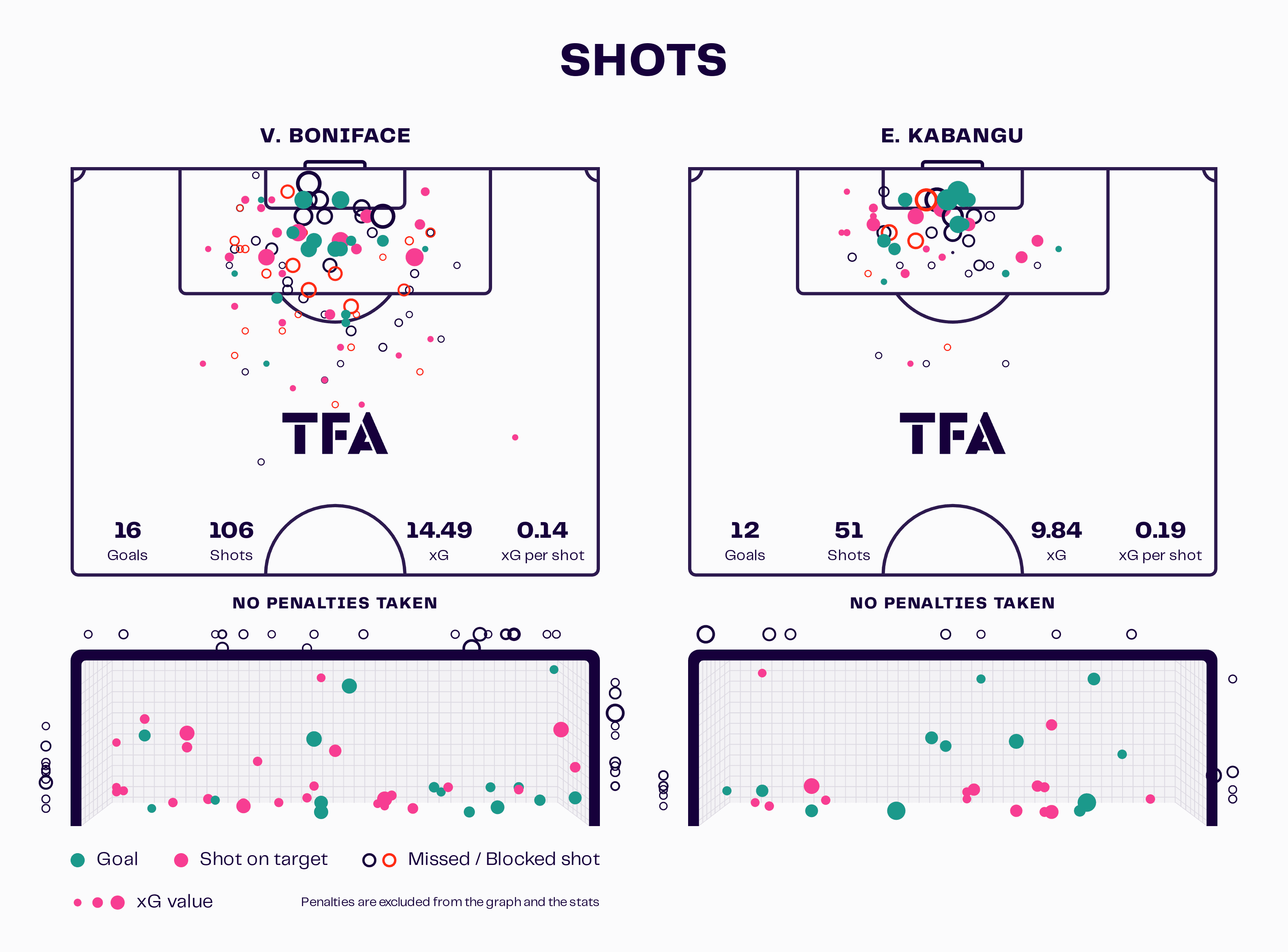



Comments